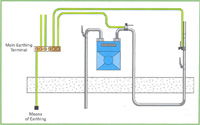Re-emerging metallic service pipework may need to be connected to the Main Earthing Terminal (MET) at the point at which it re-emerges.

In some installations, such as industrial premises, metallic pipework goes underground after the meter, and re-emerges in another location.
Such pipework may need to be connected to the main earthing terminal at the point at which it re-emerges, as well as at the point of entry into the premises.
Solution
A main equipotential bonding connection to any service pipework must be made as near as practicable to the point of entry of that service into the premises (Regulation 544.1.2 refers).
Such pipework may, after the intake position, go underground, become 'earthy' and re-emerge in another location in the premises.
There may be doubt concerning the reliability of the electrical continuity of such underground pipework. Where such pipework re-emerges, in almost all cases, it will meet the definition of an extraneous-conductive-part and must therefore be permanently and reliably connected to the MET in accordance with Regulation 411.3.1.2.
Regulation 411.3.1.2 (part of)
In each installation main protective bonding conductors complying with Chapter 54 shall connect to the main earthing terminal extraneous-conductive-parts including the following
- Water installation pipes
- Gas installation pipes
- Other installation pipes
- Central heating and air conditioning systems
- Exposed metallic structural parts of the building
Connection of a lightning protection system to the protective equipotential bonding shall be made in accordance with BS EN 62305.
Where an installation serves more than one building the above requirements shall be applied to each building
Regulation 544.1.2
The main equipotential bonding connection to any gas, water or service shall be made as near as practicable to the point of entry of that service into the premises. Where there is an insulating section or insert at that point, or there is a meter, the connection shall be made to the consumer's hard metal pipework and before any point of entry to the building if the meter is external.
This article is extracted from Snags and Solutions Part 1 or Part 2 published by NICEIC
